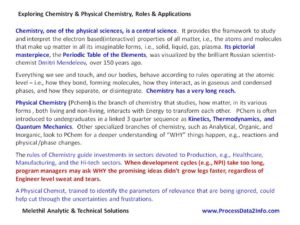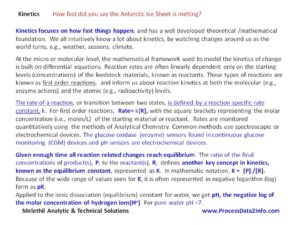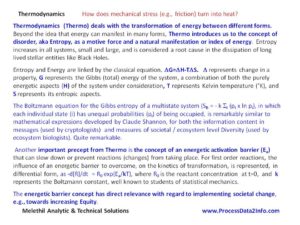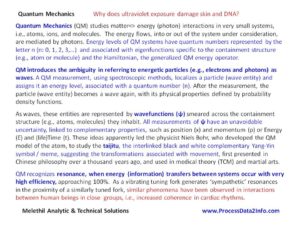Exploring Chemistry & Physical Chemistry, Roles & Apps
The list of allied scientific disciplines that draw on the foundational rules of chemistry is very large ‒ from large molecules, as in Polymer Chemistry (bio, synthetic) & Biochemistry- Physiology, to organism and ecosystem level perspectives, as in Toxicology & Applied Environmental Science.
Kinetics
Kinetics focuses on how fast things happen, and has a well developed theoretical /mathematical foundation. We all intuitively know a lot about kinetics, by watching changes around us as the world turns, e.g., weather, seasons, climate.
In many processes, from the atomic and molecular to higher order aggregated structures, first order reactions inform us about measuring the kinetics of transformations, of metamorphoses. These ideas are well developed, in a mathematical sense, at both the molecular (e.g., enzyme activities) and the atomic (e.g., radioactivity) levels.
Thermodynamics
Enthalpy (H) changes, e.g., energy (heat) flows into, or out of, material objects can be measured quantitatively using calorimetry and modern instruments like the differential scanning calorimeter (DSC). DSC allows us to compare different samples of a batch of a given material, and is often used in quality control applications.
The link between rising temperature (T) and greater entropy (S), i.e., increasing disorder, is widely neglected ‒ neglected by politicians, by the media, and by America’s Minotaur, capitalist corporate entities seeking steady increases in profits, regardless of the human and ecosystem level costs involved.
Thermodynamic perspectives on Entropy gives us insights into why the mathematically equivalent perspectives on Diversity -Equity related issues are generally shunned in discussions by government officials of all ranks, by frontline and senior managers in corporate settings, and by demagogic politicians.
The energetic barrier concept is seen in Quantum Mechanics also, i.e., the minimum energies (frequencies) needed to generate photoelectric or light reactive phenomena. Einstein received a Nobel for elucidating this concept over a hundred years ago.
Quantum Mechanics
QM results are context, i.e., experimental setup, dependent. Even great minds like Einstein resented this uncertainty.
If you ask a QM question carelessly, you may get a misleading or hard to understand answer. As one contemporary cosmologist puts it, “the universe is under no obligation to explain its workings to us.”
This warning is particularly relevant for experimenters using QM methods, (e.g., functional MRI, BOLD signal) to study the linked metabolic behaviors, i.e., collective regional oscillations, and hence, interconnectivity, of regions within our brains.



